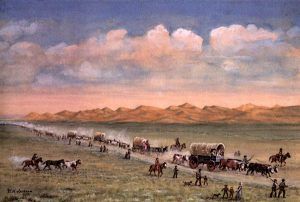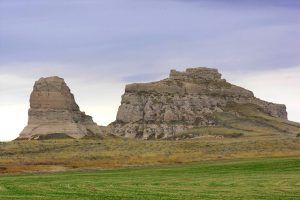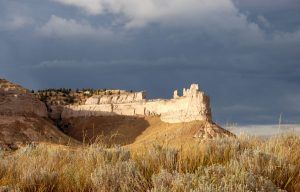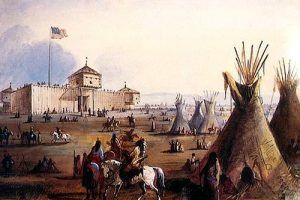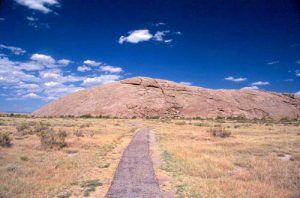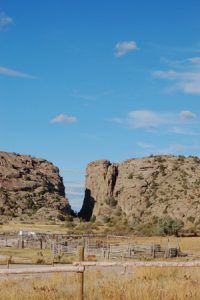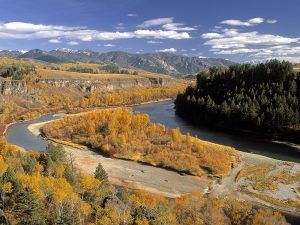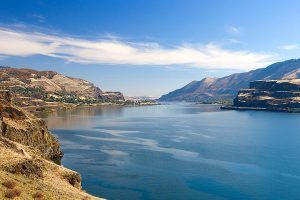Landmarks Along the Oregon Trail – Legends of America (original) (raw)
Oregon Trail pioneers pass through the sandhills, painting by William Henry Jackson.
As hopeful travelers set out on their journey across the overland trails in the 1840s and 50s, they looked forward to the fertile farmland of Oregon and the start of a new life. Although their eyes were focused on their goal, they experienced hardships and saw landmarks that lived in their memories for the rest of their lives.
Those who started their overland journey near Independence, Missouri, followed the old Santa Fe Trail for about 40 miles until the Oregon Trail branched off to the northwest. They crossed small rivers, including the Big Blue, near a lovely camp called Alcove Spring in Kansas. Edwin Bryant recorded in 1846 that the water was “as cold and pure as if it had just been melted from ice.” The area was beautifully covered with tall grass and wildflowers but swarmed with mosquitoes, which some travelers, with typical exaggeration, insisted were as large as turkeys.
The emigrants followed the Little Blue River until they reached the Platte River in Nebraska. After 1848, they stopped for a short time at Fort Kearny, the first of several forts they encountered along the trail. Although the fort was merely a group of rugged adobe buildings, it was a place of great importance where emigrants purchased supplies, shod animals, and mailed letters. The emigrants noted its unusual qualities as the wagons rolled out along the Platte River. It was often over a mile wide, yet only a few feet in depth. The word “Platte,” derived from the word “flat,” perfectly described the terrain the overlanders encountered.
After crossing the South Platte River, they began heading toward the North Platte, traveling down the steep slope now called Windlass Hill. To one emigrant, this slope seemed “a little past perpendicular.” It was so treacherous that it claimed many wagons; travelers tried to slow their vehicles down any way they could. Although they apparently used no windlasses, they often chained the wheels and locked or tied a small tree behind the wagon for resistance. Some even traveled an extra 16 to 17 miles to avoid the hill altogether.
Courthouse and Jail Rocks on the Oregon Trail in Nebraska
Emigrants began to see awesome rock formations a few miles further along the trail. Almost every journal took note of these significant landmarks, the first of which was Courthouse Rock. This large butte reminded emigrants of courthouse buildings in numerous hometowns across the Midwest. A smaller rock beside this formation was named Jail Rock. Rock formations so enthused the emigrants that many traveled several miles off the trail to take a closer look and inscribe their names upon them.
A bit farther along the trail, emigrants encountered Chimney Rock. “The only way I can describe it,” wrote S.E. Hardy in 1850, “is it looks like a big sweet potato hill with a pile of rocks on top something like a chimney.” The tip of the rock could be seen as early as three days before arriving at it. By keeping an eye on Chimney Rock, a traveler could see that slow progress was being made. Chimney Rock was about 425 feet tall (50 feet higher than it stands today) and consisted of loose clay and volcanic
ash.
Scott’s Bluff, Nebraska, on the Oregon Trail
Further along the North Platte River, emigrants came upon a prominent hill known as Scott’s Bluff, which blocked their path. This bluff received its name from early fur traders in the area. As the story goes, in 1828 or 1829, a trader named Hiram Scott became deathly ill and was abandoned by his companions, traveling 60 miles before dying. His skeleton was found at the foot of the bluff a few months later. Before 1851, wagon trains had to veer several miles to the south by way of Robidoux Pass. After the army improved the way, Mitchell Pass became the route of choice.
Beyond, one could see the faint purple shadows of the Rocky Mountains on the horizon to the West; Fort Laramie was just around the bend. Originally called Fort William, this fort was built by the fur trader William Sublette in 1834 to trade with the Indians. The American Fur Company purchased it two years later, enlarged the structure with adobe, and named it Fort John. The post was most often referred to as Fort Laramie, however, after a French-Canadian trapper named Jacques LaRames, and this was the name that stuck. Like several forts along the Oregon Trail, it was purchased by the army in 1849 and converted into a military outpost. The one thing that emigrants remembered most about the fort was the incredible prices charged for supplies. Tobacco, which might cost 5 cents in St. Louis, cost a full dollar at Fort Laramie!
Fort Laramie, Wyoming painting by Alfred Jacob Miller
Leaving the fort, emigrants set out across present-day Wyoming, entering a land poisoned with alkali. Oxen had to be beaten away from the contaminated water, and many lost their animals along this stretch. The emigrants reached potable water at the Sweetwater River.
Independence Rock was soon sighted, which “at a distance looks like a huge whale,” noted J. Goldsborough Bruff in 1849. “It is painted and marked in every way, all over, with names, dates, initials, Ec.” Independence Rock, 128 feet high and one-quarter mile long, was covered with over 5,000 names from early travelers, enough to earn it the nickname “Great Desert Register.”
Independence Rock, Wyoming
Names were chiseled, scratched, or painted on the white feldspar and granite with wagon grease and gunpowder. Some entrepreneurs charged as much as 5 dollars to create “autographs” for the illiterate. How Independence Rock originally obtained its name is not known. It may have been because it stands alone and independent from other formations or because early trappers celebrated the 4th of July there. Overlanders tried to arrive at the rock by July 4th to ensure they would make it through the mountains before the winter snows.
Devil’s Gate, Wyoming, on the Oregon Trail
Just six miles down the trail, the emigrants saw Devil’s Gate, another rock formation with a huge, narrow cleft, 370 feet high, through which the Sweetwater River ran. Since the wagons couldn’t get through the narrow defile, they traveled half a mile to the south. The gorge received its name through an old Arapaho legend, which told of a powerful evil spirit with huge tusks which once roamed the Sweetwater Valley. When warriors attacked the beast, it thrust up its tusks and ripped a huge gap through the earth, into which it disappeared.
The next and perhaps most significant landmark for the travelers was South Pass, a flat, gently sloping saddle through the Rocky Mountains, nearly 30 miles wide. Many recognized that without this pass, the Oregon Trail could not exist. Although many traveled the pass without realizing it, it was an important point along the journey. Here overlanders reached the halfway mark and crossed the continental divide.
After South Pass, some emigrants chose to leave the main trail and follow the Sublette Cutoff, which eliminated about 75 miles of travel but went through a waterless desert. Most followed the overland trail southwest past Fort Bridger instead. This fort, built by Jim Bridger and Louis Vasquez in the early 1840s, attempted to capitalize on overland travel after the fur trade’s demise. The main structure of adobe was crude and shabby compared with other forts. The Mormon Trail branched off near Fort Bridger toward the Great Salt Lake, and in 1855, the fort was purchased by the Mormons. The U.S. government took over the area and constructed a new fort in 1858.
After the Sublette Cutoff and the main trail were reunited, emigrants encountered Soda Springs, an area where mineral deposits created a landscape filled with cones, craters, springs, and geysers. Most emigrants tried the carbonated water, and some experimented by adding flavorings, sugar and citrus syrup being a particular favorite. One geyser-like water source was named Steamboat Spring since it spewed water periodically, puffing like a great steamboat. Some mountain men swore they became intoxicated when they drank at another area called Beer Spring. Most, however, thought the water just tasted a bit heavy on the sulfur.
Snake River
As travelers neared the Snake River, they passed Fort Hall, built by Nathaniel Wyeth in 1834 as a fur trading post. After following the treacherous and winding Snake River for some time, wagon trains passed through a narrow break in the rocks called the “Gate of Death.”
From the Snake River, emigrants saw a chain of hazy blue shadows on the horizon, the Blue Mountains. Luckily, crossing through these mountains turned out to be surprisingly easy, unlike their next challenge, the treacherous Dalles rapids on the Columbia River in Oregon. At the Dalles, the river dropped into a kind of sink filled with incredible boulders. The French called it “La Dalles,” meaning “the trough.” Here, just 100 miles from their goal in the Willamette Valley, travelers found themselves faced with a great land barrier and no choice but to brave the rapids aboard makeshift river craft. Luckily, at the end of the harsh water route, emigrants received help from Dr. John McLoughlin, the “Father of Oregon,” in charge of operations at British Fort Vancouver.
Columbia River
By 1846, the emigrants were offered a choice when they approached the Dalles and could take a new trail around Mount Hood to the south, cleared by emigrant Samuel Barlow. During its early use, this route, called the Barlow Road, had a toll of 5 dollars for a wagon and team. Although the charge was steep, most chose to take the road, avoiding the Columbia rapids. The road presented its own hazards. Its first section was so steep that wagons were often let down with ropes, and decades after the use of the road had ceased, rope scars could still be seen on several trees. The road was about 90 miles long and took travelers about two weeks to reach their destination, the fertile soil of the Willamette Valley in Oregon.
“Upon the whole, I enjoyed the trip,” recorded Catherine Haun, “in spite of its hardships and dangers… I, like every other pioneer, love to live over again in memory those romantic months and revisit, in fancy, the scenes of the journey.” When they reached Oregon, the emigrants didn’t have much to show for their long trip. Often, they were running dangerously low on supplies and money. They arrived in Oregon with something very valuable, however; their lives and the memory of the scenes they had experienced along the trail. Just as the landmarks they encountered had shaped the land, so their experiences shaped the future of our country.
Compiled and edited by Kathy Alexander/Legends of America, updated June 2022.
Also See:
Oregon Trail – Pathway to the West
Oregon-California Trail Across Wyoming
Oregon Trail Through the Platte River Valley, Nebraska
Source: Jefferson National Expansion Memorial
